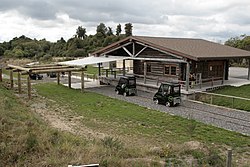Mamaku
Mamaku | |
|---|---|
 Railhead station | |
 | |
| Coordinates: 38°05′43″S 176°4′43″E / 38.09528°S 176.07861°E | |
| Country | New Zealand |
| Region | Bay of Plenty |
| Local Authority | Rotorua Lakes District |
| Ward | Rotorua Rural General Ward |
| Community | Rotorua Rural Community |
| Electorates | |
| Government | |
| • Territorial authority | Rotorua Lakes Council |
| • Regional council | Bay of Plenty Regional Council |
| Area | |
| • Total | 2.67 km2 (1.03 sq mi) |
| Population (June 2023)[2] | |
| • Total | 920 |
| • Density | 340/km2 (890/sq mi) |
Mamaku is a small village in the Bay of Plenty Region of the North Island of New Zealand. It lies on the Mamaku Plateau at an elevation of 560 metres (1,840 ft) above sea level. Situated at the highest point of the now-mothballed Rotorua Branch railway line, the town is 4 kilometres (2.5 mi) south of State Highway 5.
History[edit]
Mamaku was originally called Kaponga, but the name was changed to Mamaku in 1890 to avoid confusion with the town of Kaponga in Taranaki.[3] Ironically, the plant known as Mamaku, the Black tree fern, is not found in the area. European settlement commenced in the 1880s, and for a time Mamaku rivalled Rotorua for size.[3]
The main industry in Mamaku was originally native timber logging. In the late 19th century and early 20th century Mamaku had, at one time, 5 timber mills, all logging native timber from the surrounding bush. This reduced over time and today there are no timber mills operating in the village, with the last mill ceasing operations on 31 March 2015.
Another major industry established in Mamaku was farming, primarily dairy and sheep. This continues today as perhaps the main source of income for the village. Some recent additions to local industry include blueberry winemaking and off-road biking.
Demographics[edit]
Mamaku is described by Statistics New Zealand as a rural settlement, and covers 2.67 km2 (1.03 sq mi)[1] and had an estimated population of 920 as of June 2023,[2] with a population density of 345 people per km2. Mamaku is part of the larger Ngongotahā Valley statistical area.[4]
| Year | Pop. | ±% p.a. |
|---|---|---|
| 2006 | 726 | — |
| 2013 | 687 | −0.79% |
| 2018 | 840 | +4.10% |
| Source: [5] | ||

Mamaku had a population of 840 at the 2018 New Zealand census, an increase of 153 people (22.3%) since the 2013 census, and an increase of 114 people (15.7%) since the 2006 census. There were 267 households, comprising 399 males and 435 females, giving a sex ratio of 0.92 males per female, with 234 people (27.9%) aged under 15 years, 135 (16.1%) aged 15 to 29, 387 (46.1%) aged 30 to 64, and 81 (9.6%) aged 65 or older.
Ethnicities were 79.3% European/Pākehā, 36.8% Māori, 2.9% Pacific peoples, 2.9% Asian, and 1.8% other ethnicities. People may identify with more than one ethnicity.
Although some people chose not to answer the census's question about religious affiliation, 62.9% had no religion, 23.9% were Christian, 1.1% had Māori religious beliefs and 2.1% had other religions.
Of those at least 15 years old, 45 (7.4%) people had a bachelor's or higher degree, and 162 (26.7%) people had no formal qualifications. 33 people (5.4%) earned over $70,000 compared to 17.2% nationally. The employment status of those at least 15 was that 285 (47.0%) people were employed full-time, 81 (13.4%) were part-time, and 45 (7.4%) were unemployed.[5]
Education[edit]
Mamaku School is a co-educational state primary school for Year 1 to 8 students,[6] with a roll of 95 as of February 2024.[7]
The school opened in the village in 1895.[8]
References[edit]
- New Zealand 1:50000 Topographic Map Series sheet BE36 - Mamaku
- ^ a b "ArcGIS Web Application". statsnz.maps.arcgis.com. Retrieved 24 December 2022.
- ^ a b "Subnational population estimates (RC, SA2), by age and sex, at 30 June 1996-2023 (2023 boundaries)". Statistics New Zealand. Retrieved 25 October 2023. (regional councils); "Subnational population estimates (TA, SA2), by age and sex, at 30 June 1996-2023 (2023 boundaries)". Statistics New Zealand. Retrieved 25 October 2023. (territorial authorities); "Subnational population estimates (urban rural), by age and sex, at 30 June 1996-2023 (2023 boundaries)". Statistics New Zealand. Retrieved 25 October 2023. (urban areas)
- ^ a b Cowan, James (June 1929). "Over The Mamaku Plateau — Landscape and Story on the Rotorua Bush Line". New Zealand Railways Magazine. 4 (2). digitized by NZETC.
- ^ 2018 Census place summary: Ngongotahā Valley
- ^ a b "Statistical area 1 dataset for 2018 Census". Statistics New Zealand. March 2020. 7014691–7014695.
- ^ "Ministry of Education School Profile". educationcounts.govt.nz. Ministry of Education.
- ^ "Education Review Office Report". ero.govt.nz. Education Review Office.
- ^ "Official School Website". Internet Archive. Archived from the original on 21 February 2005.
